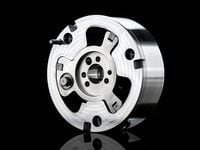Valve overlap—that crucial interval when both the intake and exhaust valves are open, expressed in degrees of crankshaft rotation—is typically a fixed parameter and always a compromise. For example, the final version of Ducati's Testastretta EVO 1198 superbike engine specified 41 degrees of valve overlap, optimal for high-rpm power. The Testastretta 11º engine, designed for the previous Multistrada and still used in the Diavel and Monster 1200, reduced valve overlap to 11 degrees, sacrificing top-end power for a low- and midrange boost.
Ducati's Desmodromic Variable Timing (DVT) effectively does away with this compromise by continuously varying valve overlap from negative 37 degrees to a maximum of 53 degrees. What does that mean? At minimum valve overlap, the exhaust valve closes to 1mm of lift 37 degrees before the opening intake valve reaches 1mm of lift. So for 37 degrees of crank rotation both valves are at or below 1mm of lift—giving no overlap. Maximum overlap, the other extreme, retards exhaust timing and advances intake timing so that both valves are at or above 1mm of lift for a whopping 53 degrees of crank angle. In this one engine, you have valve timing that's both much "tamer" than the Testastretta 11° and much "hotter" than the old 1198. Unlike some systems that move cam timing based on engine speed, Ducati's continuously adjusts both sets of cams depending on load and other factors.
The mechanics of the DVT system are actually quite simple. A hydraulic cam-phase adjuster (pictured above) sits at the end of each intake and exhaust cam, with its external housing connected to the timing belt and the internal housing rigidly fixed to the camshaft. Separating these two housings is an actuator that can rotate to advance or delay the cam timing via using engine oil metered by ECU-powered control valves.
A new, higher-volume oil pump delivers the added hydraulic pressure required by the DVT system and new knock sensors—one on each head—further inform the ECU’s myriad calculations so that changes in valve or ignition timing won’t induce detonation.
Otherwise the basic Testastretta V-twin remains essentially unchanged. Ducati’s traditional desmodromic valve actuation remains intact. In fact, the desmo system is uniquely suited to DVT, engine designer Marco Sairu says, because it requires less cam torque to open the valves, allowing the DVT adjusters to be smaller for a more compact overall system. And if you’re worried about added complexity increasing maintenance, don’t; the valve check interval of this engine is extended to 18,600 miles.














/cloudfront-us-east-1.images.arcpublishing.com/octane/FZXHNOQRNVA3BIDWAF46TSX6I4.jpg)
/cloudfront-us-east-1.images.arcpublishing.com/octane/JRSFLB2645FVNOQAZCKC5LNJY4.jpg)
/cloudfront-us-east-1.images.arcpublishing.com/octane/ITNLTIU5QZARHO733XP4EBTNVE.jpg)
/cloudfront-us-east-1.images.arcpublishing.com/octane/VZZXJQ6U3FESFPZCBVXKFSUG4A.jpg)
/cloudfront-us-east-1.images.arcpublishing.com/octane/QCZEPHQAMRHZPLHTDJBIJVWL3M.jpg)
/cloudfront-us-east-1.images.arcpublishing.com/octane/HXOUJXQWA5HBHGRO3EMJIGFMVI.jpg)

/cloudfront-us-east-1.images.arcpublishing.com/octane/3TIWWRV4JBBOLDVGRYECVVTA7Y.jpg)
/cloudfront-us-east-1.images.arcpublishing.com/octane/KIX5O23D5NAIBGFXBN3327DKZU.jpg)
/cloudfront-us-east-1.images.arcpublishing.com/octane/7GJYDUIPXRGMTMQKN6ONYOLBOU.jpg)
/cloudfront-us-east-1.images.arcpublishing.com/octane/MUQLOVLL2ZDGFH25ILABNBXKTI.jpg)
/cloudfront-us-east-1.images.arcpublishing.com/octane/TNOU5DNE2BC57MFPMGN2EIDXAM.jpg)
/cloudfront-us-east-1.images.arcpublishing.com/octane/GTCXACQGJ5HAPDTGWUQKDEH44E.jpg)
/cloudfront-us-east-1.images.arcpublishing.com/octane/S35YGSEMEZB4BLTDJTSZPF4GLA.jpg)
/cloudfront-us-east-1.images.arcpublishing.com/octane/5UOT6HPX2JFMRJAX6EH45AR4MQ.jpg)
/cloudfront-us-east-1.images.arcpublishing.com/octane/OKWOJWAKP5EP3OACCRRWPCIX2Q.jpg)
/cloudfront-us-east-1.images.arcpublishing.com/octane/2WF3SCE3NFBQXLDNJM7KMXA45E.jpg)
/cloudfront-us-east-1.images.arcpublishing.com/octane/G4MG6OUCJNBSHIS2MVVOTPX65E.jpg)
/cloudfront-us-east-1.images.arcpublishing.com/octane/IIGGWFOTOJGB7DB6DGBXCCMTDY.jpg)
/cloudfront-us-east-1.images.arcpublishing.com/octane/QSTCM6AVEZA5JJBUXNIQ3DSOF4.jpg)
/cloudfront-us-east-1.images.arcpublishing.com/octane/U4I7G625B5DMLF2DVIJDFZVV6M.jpg)
/cloudfront-us-east-1.images.arcpublishing.com/octane/B6XD6LS6IVCQPIU6HXDJSM3FHY.jpg)
/cloudfront-us-east-1.images.arcpublishing.com/octane/ICL63FEDDRDTTMINYICCEYGMDA.jpg)
/cloudfront-us-east-1.images.arcpublishing.com/octane/FCGZHQXRBZFLBAPC5SDIQLVF4I.jpg)